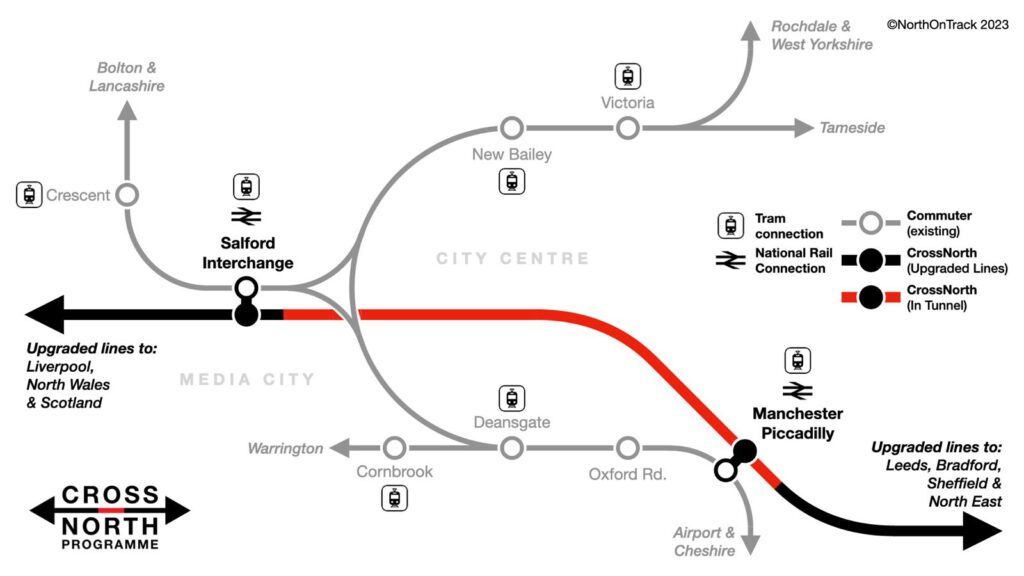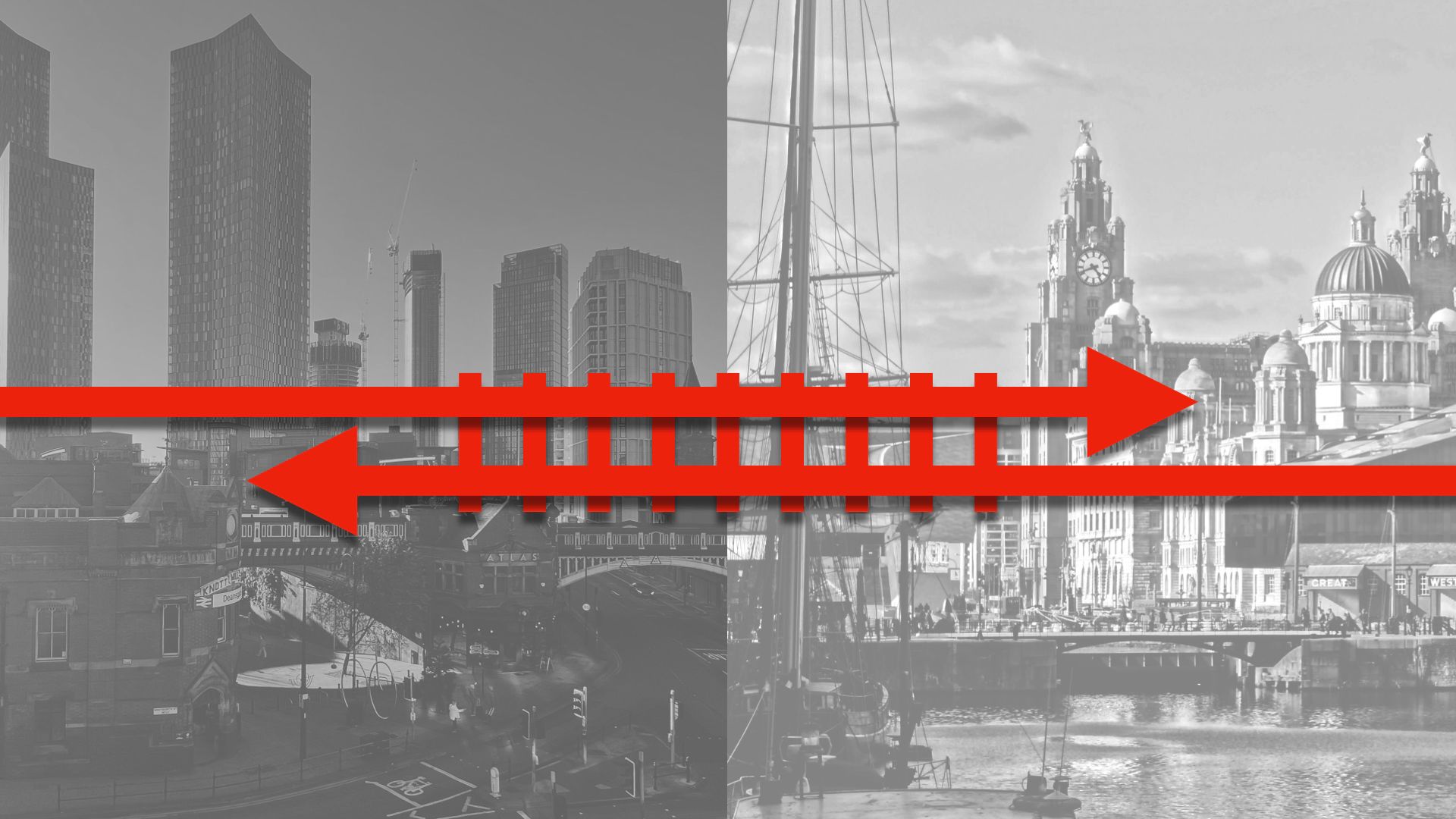Llamas are known for their distinctively long necks, and they also share an unexpected connection with the newly proposed Liverpool to Manchester railway, announced yesterday at the UK Real Estate Investment and Infrastructure Forum (UKREiiF).
Dubbed the “Liverpool And Manchester Airport Line,” or “LAMA Line” for short, the name echoes the animal’s elongated neck despite the difference in spelling. The route stretches directly east from Liverpool through Warrington and Manchester Airport before turning north toward Manchester.
However, there’s a significant issue: this llama’s legs have been chopped off. HS2, which justified this route’s design by accommodating 400m high-speed trains from the Midlands and London into Manchester, has been removed. Can a legless llama deliver what the North needs? What are the objectives of this new railway without its most critical component? What benefits will it bring to northern residents? Enroute and NorthOnTrack seek answers.
At the UKREiiF event in Leeds on May 23rd, the Liverpool-Manchester Rail Board unveiled plans for a new line between the two cities, funded by £12 billion of government funding to improve regional links. Present were the Labour Mayors of Greater Manchester and Liverpool City Region, Andy Burnham and Steve Rotheram, along with council leaders and the Managing Director of the Manchester Airports Group (MAG).
“Can a legless llama deliver what the North needs?”

As transport advocacy groups, we welcome public transport investment. However, we must hold leaders accountable and ask how such investments will benefit the public. At the event, four key points were highlighted:
- The line will connect through Warrington Bank Quay to Manchester Airport.
- Journey times from Liverpool City Centre to Manchester Airport will be reduced by 25 minutes.
- There is strong support for an underground station at Piccadilly, which remains under consideration.
- Manchester Airport is viewed as a significant economic gateway to both Manchester and beyond.
Given these points, we must ask: What is the purpose of this new line? We urge leaders to answer the following questions:
- Is it intended to facilitate future HS2 services into Manchester if a future government reinstates the project’s northern legs?
- Is it meant to significantly reduce pressure on the Castlefield Corridor, which plagues the North’s rail network?
- Will it substantially cut journey times between Liverpool and Manchester city centres and beyond?
Leaders must address these pressing questions to ensure the North gets the right solution for its rail-related woes. HS2 was designed to relieve congestion on existing lines, and any new northern line should aim to do the same, particularly through Manchester’s main bottleneck. Sixty-six percent of trains are delayed or cancelled through Oxford Road (on the Castlefield Corridor), one of the city’s busiest stations. This situation cannot continue.
“HS2 was designed to relieve congestion on existing lines, and any new northern line should aim to do the same”
The proposed new line appears from our perspective to do little to solve this critical issue. The primary reason services through Castlefield and Manchester face so many delays and cancellations is due to too many trains on too few tracks. It’s a traffic jam of trains, with different service types competing for slots in the timetable.
So, how does the LAMA line help solve this issue? Simply put, it doesn’t. It would remove only one “fast” service per hour from Castlefield and two from the route via Victoria, leaving four fast services still running through the corridor. This strangles the corridor’s potential to handle the local and regional services the region desperately needs.
To meet these objectives, we encourage leaders to explore alternative, incremental interventions, most notably the “CrossNorth Programme.”
We are also concerned that the £12-£17 billion allocated to improve links between the two cities could be better utilised with more targeted investments. We propose a Castlefield Bypass Tunnel (promoted as the “CrossNorth Programme”) from Salford to Ardwick via a new “Salford Interchange” surface station and a sub-surface station at Piccadilly (with provision for a future HS2 terminus directly above). This tunnel would be far shorter than the proposed 8-mile tunnel from Manchester Airport to Piccadilly. It would remove all fast services from the congested tracks through Manchester, finally releasing the bottleneck that has plagued the North for well over a decade.

“It would remove all fast services from the congested tracks through Manchester, finally releasing the bottleneck that has plagued the North for well over a decade.”
Salford Interchange offers an elegant solution to connectivity and capacity issues in the city centre. Strategically located between the new “CrossNorth” line and existing lines, and integrated with TfGM’s planned tram line to Media City via Salford Crescent, the proposed station serves as an ideal interchange. It enables passengers from North Manchester to access fast east-west services without overloading Castlefield and Piccadilly.
Additionally, it facilitates quick access to the growing Media City and Salford Quays, reducing travel time from Piccadilly from 30 minutes to just 5 minutes via tram. This improved accessibility supports agglomeration benefits and transit-oriented development, transforming the area into a “Mini Old Oak Common” with much-needed housing and excellent regional access. This is what “Levelling Up” is about.
Such a targeted project would be easier to deliver within a timeframe acceptable to the public and would cost substantially less than the LAMA line proposal. The remaining funding could be used to improve transport links at the Liverpool end, whether through investment in Merseyrail, an expanded Lime Street, or towards constructing a new fast railway line closely following the M62 and linking into Warrington Bank Quay via a spur, with the advantage of providing direct connections toward Chester and North Wales.
CrossNorth also facilitates “metro-style” operations on the existing network through Manchester by removing fast services and providing excellent interchange opportunities. This would enable every line into the city to support four local trains per hour, converging in a dense core. For example, Castlefield would handle 12 trains per hour from various directions converging on Manchester Airport, providing five-minute frequencies and excellent airport connectivity, comparable to Central London’s connection to Heathrow.
We put this forward as a suggestion for leaders to consider, showing that as advocacy groups, we are outcome-oriented. We ask important questions but also understand the importance of offering potential solutions.
We look forward to a public response from leaders addressing these crucial questions. At a time when it is essential for the public to fully understand the benefits of proposed infrastructure projects, it is vital that the North receives the right solution.

John
This aim to reinstate a section of HS2 to Manchester by stealth (with the blessing of Liverpool’s metro-mayor!) will not full alleviate the Castlefield corridor. A 1.5 mile tunnel paralleling the corridor will do that.
NPR needs to run from city centre to city centre ‘directly’, where most of the traffic is, not go on a scenic tour of Cheshire. Liverpool will be 35 mins from Manchester – the same as today!
Bad effort 1/10. Start again.